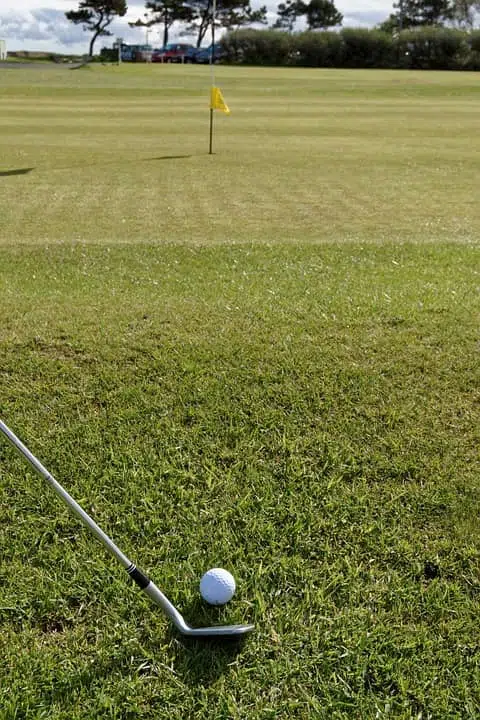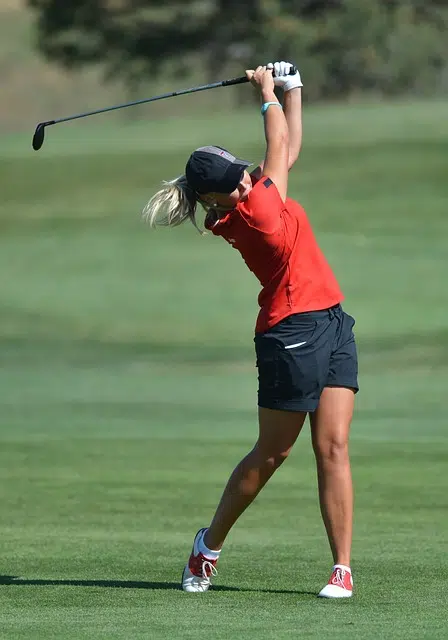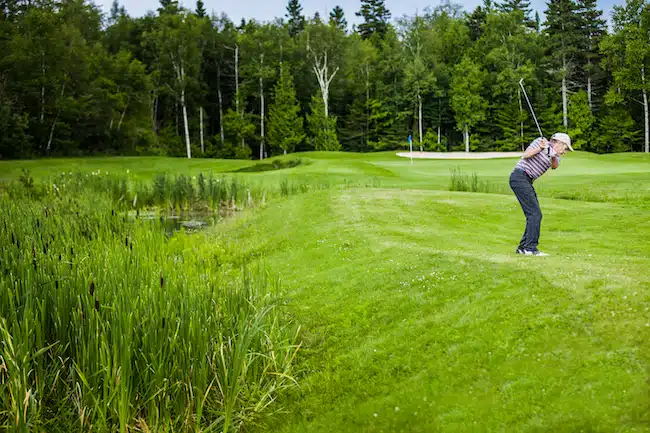The 8 iron is a crucial golf club in a golfer’s arsenal, providing a remarkable blend of distance, precision, and control. With 36 to 39 degrees of loft, it is excellent for approach shots and as a long iron, offers lots of control. On the other hand, it doesn’t give the best distance and performs poorly at lower lofts.
In this all-inclusive guide, you will learn the various aspects of the 8 iron, such as distance, loft, and launch angle, while also offering invaluable advice on effectively using an 8 iron.
You’ll also learn swing mechanics, course management, and common errors to maximize your 8 iron’s potential and enhance your overall golf performance.
This guide caters to everyone, whether you’re an amateur golfer seeking improved performance or a seasoned player aiming to refine your skills.
8 Irons: Pros and Cons
Advantages
- Versatility: The 8 iron is a versatile club that you can use in various situations on the course.
- Control: The higher loft of the 8 iron allows for better control and accuracy compared to lower-lofted irons.
- Forgiveness: Due to its design, the 8 iron is generally more forgiving and easier to hit solidly than long irons.
Disadvantages
- Limited distance: The 8 iron doesn’t provide the same distance as lower-lofted clubs, making it less suitable for longer shots.
- Not ideal for low-trajectory shots: The higher loft of the 8 iron makes it more challenging to hit low, penetrating shots when needed.
When to Use an 8 Iron

- Approach shots: The 8 iron is ideal for mid-range approach shots when you need a higher trajectory and softer landing on the green. Being able to gauge distances accurately will help you choose the right club for the shot and improve your chances of hitting it close to the pin.
- Chipping: The 8 iron can be useful for chip shots around the green when you need to get the ball up quickly and stop it on the green. Using an 8 iron for chipping can provide more control and a higher percentage shot than using a more lofted wedge.
- Escaping trouble: Use your 8 iron to play shots from the rough or over obstacles like bunkers and water hazards when you need extra loft. The 8 iron can help you safely navigate challenging situations and potentially save strokes.
Knowing when to use your 8 iron can greatly improve your course management and decision-making.
Reading Course Conditions
Course conditions can influence your choice of club, including your 8 iron. You should consider factors such as wind direction, green firmness, and elevation changes when deciding whether to use your 8 iron.
- Wind direction: If you’re playing into a strong headwind, you might need to club up to achieve the desired distance. Conversely, if you have a tailwind, you might need to club down (such as to 9 iron) to avoid overshooting the green.
- Green firmness: On firmer greens, you may want to use your 8 iron to achieve a higher trajectory and softer landing, ensuring the ball holds the green. On softer greens, you may be able to use a lower-lofted club and still achieve the desired stopping power.
- Elevation changes: Uphill shots generally require more club, while downhill shots require less. When selecting your 8 iron, factor in elevation changes to ensure you’re hitting the appropriate distance.
By taking course conditions into account and making the right club selection, you can improve your overall performance on the course and lower your scores.
What Degree Is an 8 Iron?
The 8 iron is short, with a loft typically between 36 and 39 degrees, making it an ideal choice for mid-range approach shots. The higher loft of the 8 iron allows for a higher trajectory and softer landing, making it particularly useful for shots requiring more control and precision.
However, this can vary slightly depending on the manufacturer and the specific club model. Remember that the loft of your 8 iron will directly impact the trajectory and distance of your shots.
The Impact of Launch Angle on 8 Iron Shots
The launch angle is the initial angle at which the ball leaves the clubface after impact. For an 8 iron, the ideal launch angle will help you achieve the perfect balance between height and distance, allowing your ball to land softly on the green with minimal roll.
Paying attention to your 8 iron launch angle is crucial to optimize your ball flight and thus maximize your chances of hitting your target.
Factors Affecting Launch Angle
Several factors can impact the launch angle of your 8 iron shots, and understanding them in more detail can help you optimize your performance on the course:
Club Loft
The loft of your 8 iron plays a significant role in determining the launch angle. A higher loft generally produces a higher launch angle, while a lower loft produces a lower launch angle.
This is important to consider when selecting the right 8 iron for your game, as different manufacturers may have slightly varying lofts for their 8 irons.
Swing Mechanics
Your swing speed, angle of attack, and the way you strike the ball can all influence your launch angle. For example:
- Swing speed: Faster swing speeds can increase launch angles due to increased backspin and dynamic loft at impact.
- Angle of attack: A steeper angle of attack (hitting down on the ball) can increase the launch angle, while a shallower angle of attack (sweeping the ball) can reduce the launch angle.
- Ball striking: Striking the ball high or low on the clubface can affect the launch angle, with higher contact points generally producing higher launch angles.
Working with a golf instructor can help you improve your swing mechanics and optimize your launch angle with your 8 iron. You will learn everything about your specific 8 iron, paying attention to factors such as swing speed, angle of attack, and ball striking.
Ball Position for Optimal Launch Angle
Placing the ball too far forward or backward in your stance can affect the launch angle. Ideally, you should position the ball slightly forward of the center of your stance for an 8 iron.
This promotes a slightly descending blow, ensuring the optimal combination of launch angle and spin rate for maximum 8 iron distance and control.
Equipment
The type of ball you’re using, and the shaft flex of your 8 iron golf club can also impact the launch angle. For example:
- Golf balls: The type of golf ball you use can have a significant impact on launch angles, with softer, higher-spinning balls producing higher launch angles and firmer, lower-spinning balls leading to lower launch angles.
- Shaft flex: Stiffer shafts can decrease the launch angle by reducing dynamic loft at impact, whereas more flexible shafts can raise the launch angle by increasing dynamic loft.
By comprehending and adjusting these factors, you can optimize your 8 iron’s launch angle for superior performance on the golf course.
What Is The Length of an 8 Iron?
Typically, the standard length of an 8 iron is approximately 36.5 inches for men and 35.5 inches for women. However, these measurements can fluctuate slightly among manufacturers and models.
Some golfers may also customize the length of their 8 iron to better accommodate their swing and physique.
Your 8 iron’s length can significantly influence your swing mechanics and the resulting shots. A longer 8 iron may help you generate more swing speed and distance but might also be more challenging to control and maintain consistent ball contact.
Conversely, a shorter 8 iron can provide better control and accuracy but may restrict your average 8 iron distance potential.
Choosing the Right Length for Your Game
When selecting the appropriate length for your 8 iron, consider factors like your height, swing style, and personal preferences. It’s crucial to strike the right balance between distance and control to maximize your 8 iron’s capabilities.
Custom club fitting is a fantastic method to guarantee that you use the ideal length for your game.
8 Iron: Swing Speed and Clubhead Speed

Swing speed relates to the pace of your club movement, while clubhead speed is the velocity of the clubhead at the moment it strikes the ball. Both factors are crucial in shaping the club distance and trajectory of your 8 iron shots.
Here is a general swing speed chart for 8 irons, based on various skill levels:
| Swing Speed (mph) | Carry Distance (yards) |
| 70-79 | 100-130 |
| 80-89 | 130-145 |
| 90-99 | 145-160 |
| 100-109 | 160-175 |
| 110-119 | 175-190 |
Factors Affecting Swing Speed and 8 Iron Clubhead Speed
Numerous factors can impact your swing speed and clubhead speed with an 8 iron, including:
- Physical prowess and conditioning: Golfers with strength and flexibility can typically generate higher swing speeds.
- Technique and mechanics: Adopting efficient and proper techniques can aid in maximizing your 8 iron swing speed.
- Equipment: Your 8 iron’s shaft flex, weight, and length can all impact your swing and clubhead speed. We recommend looking into the size of golf clubs that would best fit you.
Optimizing these aspects can boost your swing and clubhead speeds, leading to longer and more precise shots with your 8 iron.
How to Hit 8 Irons Effectively — Grip, Stance, and Ball Position

The grip is the sole connection between you and the club, making it essential to get it right. There are three prevalent grip styles: the interlocking grip, the overlapping grip, and the baseball grip. Each has its advantages, and you should choose the one that feels most comfortable and secure for you.
- Interlocking grip: The pinky finger of your trailing hand interlocks with the index finger of your leading hand.
- Overlapping grip: The pinky finger of your trailing hand overlaps the index finger of your leading hand.
- Baseball grip: All ten fingers remain on the club without interlocking or overlapping.
Regardless of the grip style, you should hold the club in your fingers, not your palms. The V-shape created by your thumb and forefinger should point toward your trail shoulder for a neutral grip. This allows you to hinge your wrists correctly during the swing and maintain control of the clubface.
Proper Stance and Alignment
A proper stance is essential for balance and stability throughout the swing. Stand with your feet shoulder-width apart and position the ball slightly forward of the center of your stance.
This helps you make solid contact and achieve the desired launch angle. You achieve proper alignment by positioning your feet, hips, and shoulders parallel to the target line.
Maintain a slightly bent knee and tilt your upper body forward from your hips, keeping your back straight. This athletic posture enables smooth rotation during the swing.
Ball Position for 8 Iron Shots
For an 8 iron, the ideal ball position is slightly forward of the center in your stance. This promotes a downward strike on the ball, resulting in the optimal combination of launch angle and spin rate for maximum distance and control.
Too far forward, you risk hitting the ball thin or with an upward attack angle, leading to losing distance and control. Too far back, and you risk hitting the ball fat or with a steeper angle of attack, which can produce inconsistent results.
Swing Mechanics and Tempo
When swinging your 8 iron, focus on these key points during the takeaway and backswing:
- Takeaway: Keep your arms and club connected to your body as you start your backswing. This promotes a one-piece takeaway, ensuring a smooth and controlled motion.
- Backswing: As you rotate your shoulders and shift your weight to your back foot, maintain a smooth and controlled tempo. Refrain from rushing the backswing, as it may result in poor timing and inconsistent ball striking
Transition and Downswing Dynamics
The shift from backswing to downswing is vital in the golf swing. Maintain your focus on the following components:
- Transition: As you transition from backswing to downswing, transfer your weight to your front foot while keeping your head stable. This method encourages proper sequencing and positions you powerfully to contact the ball.
- Downswing: As you swing down, focus on maintaining lag (the angle between your lead arm and club shaft) and avoid casting the club (releasing the angle too early). This helps maximize clubhead speed at impact, leading to longer, more consistent shots.
Impact and Follow-Through
Making solid contact with the ball is crucial for hitting your 8 iron effectively. Consider these points:
- Impact: Strike the ball with a descending blow, hitting the ball first and then the ground. Also, ensure you stay behind the iron, leaning back from the target on impact. This way, you’re guaranteed to get optimal compression, spin, and launch angle, thus maximizing distance and control.
- Follow-through: Complete your swing with your weight on your front foot and your body facing the target. A balanced and complete follow-through, with your weight on the front foot and body facing the target, signifies a well-executed swing and ensures consistent ball striking.
Check out this video if you still struggle understanding the proper technique.
8 Iron: Common Mistakes and Fixes
Why Do I Chunk My Irons?
If you frequently hit the ground before the ball (chunking), focus on shifting your weight forward during the downswing and maintaining a steady head position. This promotes a proper angle of attack, ensuring you strike the ball before the ground.
Drills encouraging proper weight shift, such as stepping drills or swinging with your feet together, can help correct this issue.
Why Do My Golf Club Irons Go Right to Left?
You produce a draw or hook if your shots consistently curve from right to left. This can result from an overly strong grip or an inside-to-out swing path.
To fix this, check your grip to ensure it’s neutral and not overly strong. Work on swinging the club along a more neutral path by practicing with alignment sticks or other visual aids to ensure your club is traveling on the correct path.
FAQs
How Far Do PGA Players Hit an 8 Iron?
On average, PGA players hit their 8 iron between 150 and 170 yards. However, individual distances can vary depending on factors such as swing speed, launch angle, and course conditions. We strongly advise you to not compare your own shots with the pros and instead focus on improving your technique.
Can You Hit an 8 Iron 150 Yards?
It’s possible for amateur golfers to hit an 8 iron 150 yards, but they require a fast swing speed and a stellar swing to do so. As such, few amateurs will hit this mark. Typically, most hit their 8 iron between 110 and 140 yards, and this is a perfectly respectable distance.
Is an 8 Iron Easy to Hit?
The 8 iron is generally easier to hit than long irons due to its higher loft and shorter length. However, like any golf club, practice and proper technique are necessary to achieve consistency. By focusing on fundamentals such as grip, stance, and ball position, you can improve the quality of your 8 iron usage.
How Do I Deloft Irons?
To deloft your irons, you can try adjusting your ball position, keeping your hands ahead of the clubhead, leaning the shaft slightly forward at impact, and practicing regularly. However, it's important to remember that delofting irons is a challenging technique that requires precise timing and ball-striking skills.
Conclusion
By understanding the intricacies of the 8 iron and applying the tips provided in this comprehensive guide, you’ll be well on your way to mastering this versatile club.
Remember to focus on technique, practice regularly, and always keep learning. With dedication and persistence, you’ll soon see improvements in your 8 iron shots and overall golf game. Now, get out there and start swinging!
Clint is PGA-certified and was a Head Teaching Professional at one of Toronto's busiest golf academies. He was also featured on Canada's National Golf TV program, "Score Golf Canada," twice. He graduated with a degree in Golf Management from the College of the Desert in California and studied under Callaway's co-founder, Tony Manzoni.
He has a handicap index of 6.2 and spends the winters near Oaxaca, Mexico, where he plays twice a month at the Club de Golf Vista Hermosa. He's written over 100 articles at GolfSpan since 2021. You can connect with Clint at LinkedIn, FB, his website, or Clintcpga@gmail.com.
- Best score: 68
- Favorite club: Odyssey White Hot Two-Ball Center-Shafted Putter
- Favorite ball: Titleist Pro V1x
- Favorite food at the turn: Hot dog








